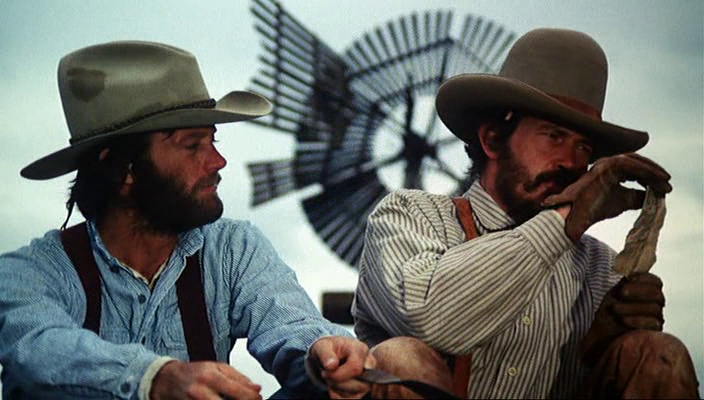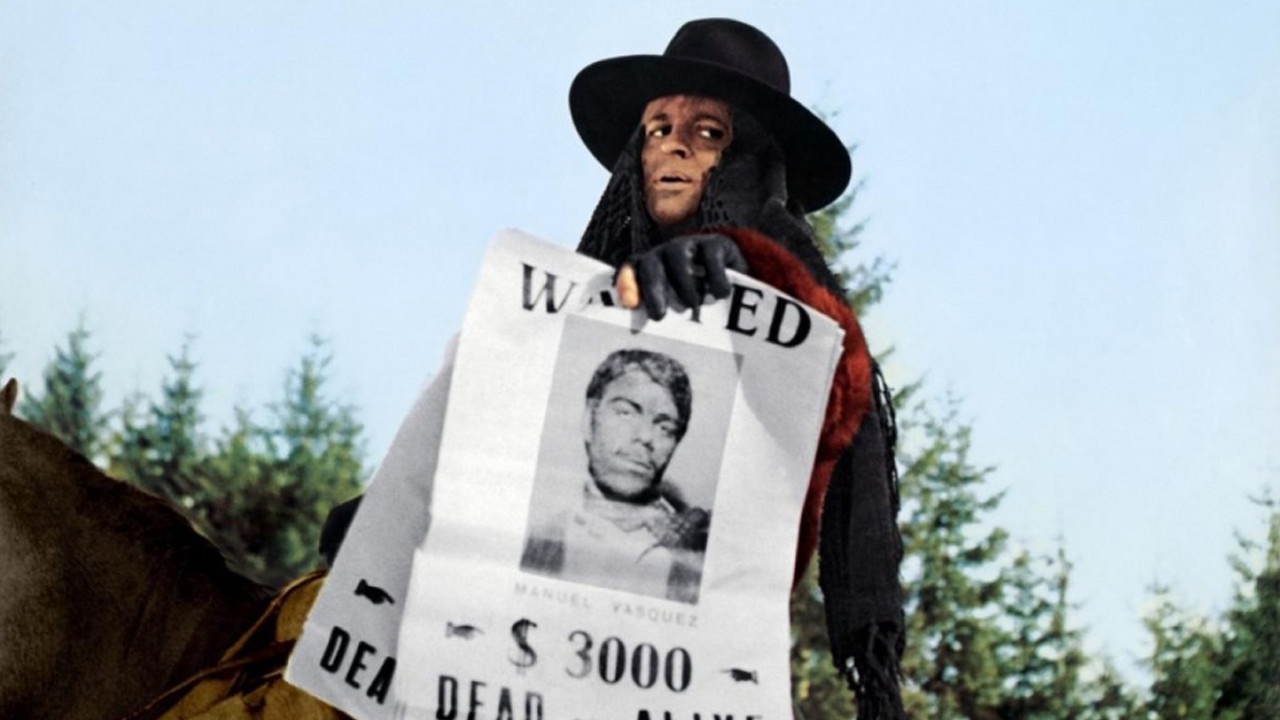
The western has been a quintessentially American film genre since the silent era, however, its dimensions considerably expanded during the sound era, from John Ford’s Stagecoach (1939), My Darling Clementine (1946), The Searchers (1956), and The Man Who Shot Liberty Valance (1962) to Fred Zinnemann’s High Noon (1952) and George Stevens’ Shane (1953).
One of the foremost actors of the genre during the 1940s-1950s was John Wayne and due to both his own preferences and the Hays Code enforced since the 1930s, he was always the good guy defeating the bad guys (although The Searchers displayed some darker tendencies in his character’s racism towards Native Americans). One of the only westerns during this time period that bucked this trend was John Huston’s Treasure of the Sierra Madre (also one of the first Hollywood movies filmed on location outside the United States in Mexico) that featured Humphrey Bogart in his best performance as a paranoid villain.
When the Hays Code disappeared in 1968 and a ratings system kicked in that allowed adults to witness moral complexity, sex, and violence in films, a new breed of directors, such as Sam Peckinpah and Robert Altman pushed the envelope, The Wild Bunch (1969) displayed slow motion bloody gunfights and criminal protagonists, while in McCabe & Mrs. Miller (1971) the protagonist is a gambler and pimp who does not triumph against the villains of big business corporate capitalism.
The Italian film director Sergio Leone had already altered the western genre with For a Few Dollars More (1965) (according to Alex Cox, the most brutal deaths in an Italian western because it is a mother and her child, even though it occurs offscreen and is not shown) and Once Upon a Time in the West (1968) where Henry Fonda (the all American hero of earlier westerns) is cast as the brutal Frank who kills a kid point blank in one of the opening sequences.
The western genre began to change during the 1950s and was then forever transformed after the radical upheavals of the 1960s-1970s. There are other westerns (American, Italian, even French) that are lesser known yet these films definitely deserve to be viewed because they subvert traditional western expectations. These are 10 hidden gem westerns you should see.
1. The Hired Hand (1971)

Actor Peter Fonda was fresh from the counterculture success of Easy Rider and for his directorial debut he decided to film a story by screenwriter Alan Sharp that was ahead of its time in the character (feminist!) of Hannah Collings (a strong woman who was abandoned by her husband, portrayed powerfully by Verna Bloom). An American western unlike any other, Peter Fonda and Warren Oates in their best performances share a friendship in the film that is poignant, particularly during the sad ending.
Beautiful, gorgeous, shimmering landscapes of New Mexico photographed by brilliant cinematographer Vilmos Zsigmond. Editor Frank Mazzola’s freeze-frames, slow motions, and superimpositions of Zsigmond’s images create montages that are hazy, psychedelic tapestries complemented by the aching, deeply hypnotic soundtrack composed by Bruce Langhorne that perfectly captures the mournful feeling of the lonesome frontier. Mystical, poetic, quiet, reflective, spiritual.
2. The Great Silence (1968)

Jean Louis Trintignant is a mute gunslinger seeking justice for his scarred past in his best performance and Vonetta McGee (in her first major film role and greatest performance) is the grieving widow Pauline Middleton, a strong woman who wants vengeance after suffering the murder of her husband. Klaus Kinski as Loco is one of the most cold blooded and cruel villains of any Italian western. Luigi Pistilli is the corrupt banker Policutt funding the bounty hunters. Silvano Ippoliti’s wintry cinematography of the Dolomite mountains is stunning. Sergio Corbucci intended the story to be a political statement mourning the deaths of revolutionaries during the 1960s.
This film is arguably the greatest Italian western for numerous reasons–Ennio Morricone’s most celestial and deeply haunting soundtrack (the maestro’s own personal favorite of his scores), the melancholy performances and relationship between Trintignant and McGee (including an intense interracial love scene that was ahead of its time), and the bleakest, most tragic ending in the history of westerns.
3. Cemetery Without Crosses (1969)

Actor-director Robert Hossein and Michele Mercier share a chemistry that is compelling. Almeria is filmed at its most desolate and dusty. Michele Mercier (more known for her smaller roles in Francois Truffaut’s Shoot the Piano Player and Mario Bava’s Black Sabbath) is given a character of depth, Maria, who (like Vonetta McGee’s character Pauline in Great Silence) suffers the murder of her husband, this is her most memorable performance, both melancholy and strong.
Robert Hossein’s direction and performance are minimalistic, spare, and stark. Scott Walker (whose cinematic genius graced his two best albums that same year in 1969 on Scott 3 & Scott 4) brings his epic grandeur to “The Rope and the Colt” that he sings on the opening credits. (“I swore a vow on my dying breath/To ride a trail that ends in death/And death could strike with a frightening jolt/Of a lightning bolt/In the land where the rope and the colt are king.”) The atmospheric soundtrack was composed by Hossein’s father Andre.
4. The Mercenary (1968)

Comical, energetic, free spirited, political, rambunctious, and wild Zapata western (by far the best of its subgenre) set during the Mexican Revolution featuring fantastic performances from Franco Nero as the mercenary Sergei Kowalski, Tony Musante as Paco the rebel, Giovanna Ralli as the earthy, strong Columba, and Jack Palance as the crafty villain Curly. Ennio Morricone’s soundtrack summons desert vibes, both reflective and rousing.
Highlights include Musante making a mine owner eat a lizard and Nero making a cardsharp eat his loaded dice, a fight sequence between Nero and Musante that is madcap, Giovanna Ralli dressed up as Jesus during a parade ambush, and a final showdown by director Sergio Corbucci that is not only incredible, it is also unique and unusual, a bullring clown (Musante) facing his enemy (Palance).
5. Track of the Cat (1954)

Just right for a cold winter’s night. Stately and luminous Cinemascope photography by William H. Clothier of the snowy mountain wilderness surrounding Mount Rainier, Washington.
The ensemble cast deliver terrific portrayals, Philip Tonge as a drunken father, Beulah Bondi as a bible quoting bitter mother, Teresa Wright as the strong willed sister stubborn against her mother’s judgments and her brothers’ bickerings, and Carl Switzer (Alfalfa from Little Rascals) as a Native American Joe Sam (!) who is abused by Robert Mitchum, the dominant macho member of the family, and warns them about the black panther in this tangled tale. There are many moments of absurd and unexpected humor (such as Robert Mitchum’s readings of John Keats’ lines “When I have fears that I may cease to be”).